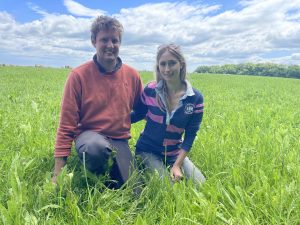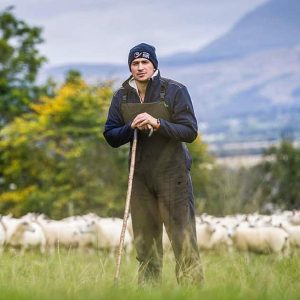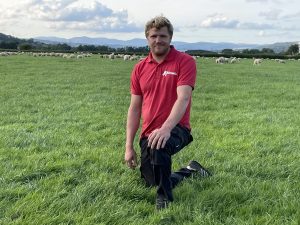with kind permission of Aled Davies – Pruex
The Perkins family farm at Dinas Island in West Wales and are one of the main ram producer farms for Innovis, with 500 Abermax stock ewes and a 1,000 strong Lleyn fock with 500 in the Aberfield SR programme and 500 put to a Lleyn ram for pure breeding.
The ewes are housed in December for March lambing due to the harsh weather conditions confounded on Dinas Island by a lack of shelter, and are turned out following the recording of ewe and lamb data, such as ease of lambing and birth weights.
Prior to implementing the Pruex 5 Point Plan the farm were using lime with straw bedding in an attempt to limit various health issues including joint ill. Pregnant ewes were moved out of their pens weekly and run through an external footbath in an attempt to combat lameness. The worst ewes being targeted and segregated for individual antibiotics treatment. Maintaining clean and dry bedding was a constant battle. Detailed record keeping highlighted the costs of culling heavily according to foot health. Repeat offending ewes with foot problems were culled from the flock increasing the number of ewe lamb replacements needed. Neil noted that prior to using the Pruex products the farm records magnified that foot treatments were the main health burden and were utilising a significant amount of time, resources and money.
Since using Pruex in the lambing shed and in the water supply from December 2018 onwards, the family have stopped using lime as well as foot bathing completely and have seen significant reductions in lameness and lamb infections such as joint ill which used to occur in 2 to 3% of lambs. Pruex Stabiliser is applied as a mist directly onto the bedding in the ewes pens as well as the individual mothering pens daily. Neil has made some rough calculations himself and believes that by drying up the bedding with the mist of Pruex Stabiliser the savings in straw alone equate to the cost of the Pruex products, and that other health benefits such as reduced lameness and lamb infections such as joint ill are a bonus. His antibiotic bill has reduced by £3,000 annually, a major objective of his flock health plan.
“The sheep sector is a low net user of antibiotics when compared to other meat sectors, but do use heavily during the lambing period. It’s been the focus of our work for this sector at Pruex, and this type of reduction shows what can be achieved in a small amount of time when farmers have the determination and focus portrayed by the Perkins family”, said Aled Davies, founder of the company. Water treatment is done via a dosatron pump with the whole farm receiving treatment 365 days of the year. This incorporates into the rotational grazing program utilised with each water trough readily treated. The water troughs are routinely cleaned before fresh break moves and given an extra 300ml shock treatment of Pruex Water Plus plus as the trough refills.
The detailed record keeping of foot treatments continues and in 2019 the total treatments on the farm have dropped by 68% and the total for 2020 in on track to mirror that improvement. This not only saves time and labour, but it has also reduced the culling rate on the farm due to a reduction in repeat offenders. The farm have also noted a significant reduction in Joint ill cases which were previously treated by catching lambs outdoors, with problem cases injected with antibiotics. Since the 2019 lambing the number of joint ill cases have reduced greatly with only 3 lambs needing treatment annually.
The plan of action for the 2020 lambing season is to build on the knowledge gained over the last two lambing seasons. In addition to misting the bedding with Pruex Stabiliser and treating the water with Pruex Water Plus, and in order to reduce both workload and toxic bacterial loading on new-born lambs, Pruex Base Layer will be used instead of lime and straw in the mothering pens. Pruex Base Layer is dust extracted chopped straw (2cm), treated at bagging with Pruex bacteria. It will be used in conjunction with Pruex Stabiliser to absorb moisture and populate good bacteria in the area where lambs need protection during the early stages of their lives.



